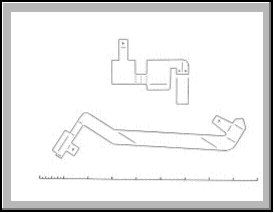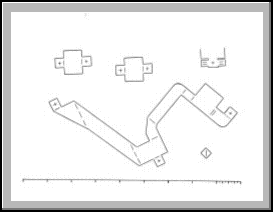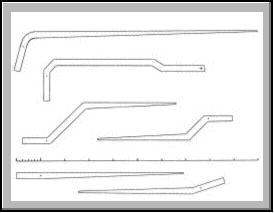|
|
|
 Oscillator Templates - Make 2 of each complete template.
Apply double sided Scotch tape to paper. Overlap each part approximately 1/8". For antennas use a single strip of tape. Prepare 12
aluminum cans by washing, cutting open with scissors, and flattening. Flatten by sliding (not rolling) over a broom stick. Apply
templates to aluminum sheets. Mark fold lines with a glass cutter. Mark hole centers with a sewing pin. Sand contact areas with
#150 sandpaper before cutting. Cut on lines as shown:
Oscillator Templates - Make 2 of each complete template.
Apply double sided Scotch tape to paper. Overlap each part approximately 1/8". For antennas use a single strip of tape. Prepare 12
aluminum cans by washing, cutting open with scissors, and flattening. Flatten by sliding (not rolling) over a broom stick. Apply
templates to aluminum sheets. Mark fold lines with a glass cutter. Mark hole centers with a sewing pin. Sand contact areas with
#150 sandpaper before cutting. Cut on lines as shown:
PART> ..ooOOOoo.. <SCRAP
______________^ cut here
 Remove patterns and sand all edges from both sides. Sand remaining contact areas.
The incomplete pattern shown is a design for a spark gap base that will have flaps to extend and wrap around the spark gap vent
tubes. The purpose is to capacitively recover some of the energy lost from the spark itself. It may make the transmitter more
efficient. It will make the construction much harder. Build the regular ones first. The incomplete extension in the upper template is
to make a connection without using a banana jack. It is also harder to assemble.
Remove patterns and sand all edges from both sides. Sand remaining contact areas.
The incomplete pattern shown is a design for a spark gap base that will have flaps to extend and wrap around the spark gap vent
tubes. The purpose is to capacitively recover some of the energy lost from the spark itself. It may make the transmitter more
efficient. It will make the construction much harder. Build the regular ones first. The incomplete extension in the upper template is
to make a connection without using a banana jack. It is also harder to assemble.
 These are the antennas. The dot on the end of each one shows how far it gets
inserted into the antenna jack / output capacitor. The straight antenna will stay in place without support. The offset antennas will
need additional support from webs of fishing line added inside of the bucket. Support from soda straws is another method. Try to
limit the contact of the supports to the antennas. They will be capacitive loads (losses) to the RF energy. Also limit the support
material within an inch or two of the antenna for the same reason.
These are the antennas. The dot on the end of each one shows how far it gets
inserted into the antenna jack / output capacitor. The straight antenna will stay in place without support. The offset antennas will
need additional support from webs of fishing line added inside of the bucket. Support from soda straws is another method. Try to
limit the contact of the supports to the antennas. They will be capacitive loads (losses) to the RF energy. Also limit the support
material within an inch or two of the antenna for the same reason.